-VNEyS.medium.jpg)
Kaohsiung (高雄; Ko-hiông in Minnan, Gāoxióng in Mandarin), with over 2.7 million inhabitants, is the third most populated city in Taiwan after New Taipei and Taichung. It in the south of the island on the west coast. Kaohsiung is known for its harbor, although more for commercial than tourism reasons. Hence it is also known as the Harbor Capital (港都) of Taiwan. Its year-round fine weather and the low cost of living makes Kaohsiung the place to visit.
Kaohsiung is Taiwan's third largest city and its largest port. Although the ranking has declined, Kaohsiung is still the world's 14th largest cargo-container seaport as of 2018. The city has high concentrations of heavy industry, including steel production, shipbuilding, and other exports that have led to Kaohsiung's relatively high levels of air pollution (though the situation has improved substantially). Unlike Taipei, Kaohsiung is a planned city with wide streets and slightly less traffic congestion than the capital. The city has made great strides in transforming itself from a primarily industrial city into a modern Asian metropolis, and several areas of the city, such as along the banks of the Love River (Ai He, 愛河), have benefited from major beautification projects under the tenure of former mayor Frank Hsieh. The city is often known as Taiwan's "Harbor Capital" (港都) because of its close connection and heavy reliance on the ocean and maritime transportation.
Kaohsiung began in the 17th century as a small fishing village named "Takao" (打狗), derived from the local aboriginal name meaning "bamboo forest". The name was changed to "高雄" (meaning: "high hero") by the Japanese in 1895, also pronounced "Takao" in Japanese, as they found the original name of 打狗 ("beating the dog") to be vulgar. The modern name of "Kaohsiung" is the pronunciation of "高雄" in Mandarin.
Many visitors coming from the north will arrive by high-speed train at the Zuoying High Speed Train Station, which is far to the north of the city. The city center around the Central Train Station and the Formosa Boulevard Subway Station can be accessed via the MRT's red line.
Another common point of entry is the Kaohsiung International Airport, which is comparatively close to the city. The airport is on the MRT's red line, and the central area of town is a 20 minutes MRT ride away. There is a tourist information office on the ground floor of the international terminal.
Kaohsiung enjoys a mild tropical climate, comparatively milder and drier than northern Taiwan. The weather however remains hot and sticky in the summer, with June, July and August seeing the most rainfall. Still, the proximity of the sea makes the summer heat much more bearable than in other cities at a similar latitude, such as Hong Kong.
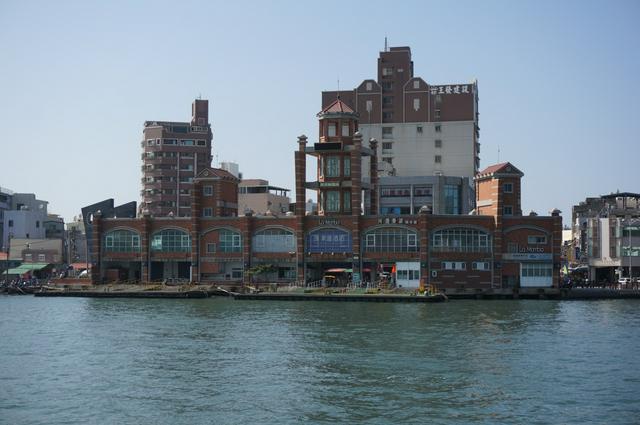
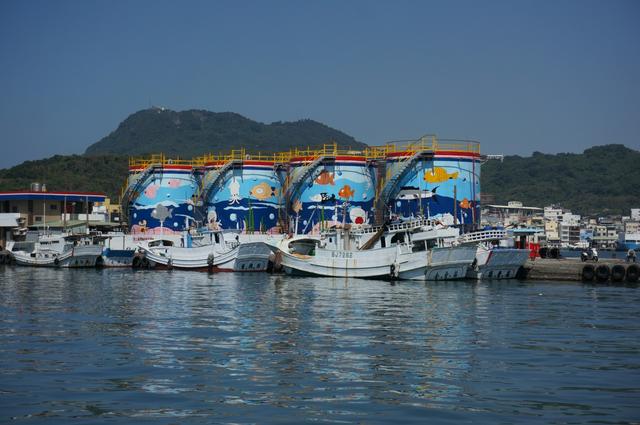
The Cijin District (旗津; Qijin) is a slender island in Kaohsiung harbor which serves as a natural breakwater for the harbor. The district is filled with seafood restaurants selling freshly caught seafood which can be prepared right after you pick it out. Cijin is connected to the rest of Kaohsiung City by underwater tunnels, but the transportation of choice is one of the many ferries that traverse the harbor. Fare for the ferry ride is NT$15 per person. Bikes and scooters can be brought aboard, but the fee is NT$30 with a scooter. There is no extra fee for bringing on a bike. The ferry is easily accessible for wheelchairs, which can share the space with scooters and bikes. The street that goes straight from the ferry has about two blocks of snack stands, as well as seafood restaurants near the end. There is also a plaza with a fountain and a beach at the end of the street. If you rent a bike (either before or after the ferry ride), there is a nice coastal path that goes south along the beach. Going a short ways north will lead you to the lighthouse and the fort, which are located on a hill with great views of the city, the harbor, and the ocean. The area is especially crowded on weekends with many visitors bringing their entire family along. The island is also projected to be an international tourism spot in southern Taiwan by the city government. However, at present it's somewhat run-down.
- Cijin Coast Park, No.990 Qijin Third Road, Qijin District, Kaohsiung, Taiwan. The Cijin Seaside Park is a long area of picturesque terrain along the west coast of Cijin Island. Take a leisurely stroll past intriguing architectural designs with a constant view of the Taiwan Strait. The park incorporates a long path for walking and cycling as well as an ecological area and Cijin Beach.
- ChiHou Lighthouse, * 34, Chi-Xia Lane, Chi-Jin District.. The lighthouse was built by English technicians in Ching Dynasty (1883). In 1916, the Japanese remodeled it into Baroque stye and painted it white. This renovation was made as part of the expasion of Dagao port. The lighthouse has played a crucial role in guiding ships since 1918 during night sailing
- Chihou Fort, * 34, Chi-Xia Lane, Chi-Jin District.. Chihou Fort is a battery which was designed by English engineer. It was after the Cing (Qing) government took over Taiwan that the fort became a military base. The fort stationed a naval commander and one hundred soldiers. The battery was also armored with four British-made Armstrong breecholders weighing 6.5 tons each. The fort was occupied by the Japanese army in 1895. Subsequently, the cannons in the fort were dismantled and melted. Meanwhile the battery was abandoned. In 1988, Kaohsiung city government started to restore the battery and it was completed in 1992. As a result, a new Cihou battery was reborn to please the tourists.
- TianHou Temple, * 39, Miao-Chen Road, ChiJin District.. Chihou area is a place in Kaohsiung city that most fishermen live. This temple is built about three hundreds years ago, and dedicated to the Goddess of Sailors, Matzu. People believe that Matzu can protect every fisherman who put out to sea. The temple is crafted with charming yet authentic folk art. TianHou temple is also regarded as the oldest temple in Kaohsiung.
Cijin Coast Park, No.990 Qijin Third Road, Qijin District, Kaohsiung, Taiwan. The Cijin Seaside Park is a long area of picturesque terrain along the west coast of Cijin Island. Take a leisurely stroll past intriguing architectural designs with a constant view of the Taiwan Strait. The park incorporates a long path for walking and cycling as well as an ecological area and Cijin Beach.
ChiHou Lighthouse, * 34, Chi-Xia Lane, Chi-Jin District.. The lighthouse was built by English technicians in Ching Dynasty (1883). In 1916, the Japanese remodeled it into Baroque stye and painted it white. This renovation was made as part of the expasion of Dagao port. The lighthouse has played a crucial role in guiding ships since 1918 during night sailing
Chihou Fort, * 34, Chi-Xia Lane, Chi-Jin District.. Chihou Fort is a battery which was designed by English engineer. It was after the Cing (Qing) government took over Taiwan that the fort became a military base. The fort stationed a naval commander and one hundred soldiers. The battery was also armored with four British-made Armstrong breecholders weighing 6.5 tons each. The fort was occupied by the Japanese army in 1895. Subsequently, the cannons in the fort were dismantled and melted. Meanwhile the battery was abandoned. In 1988, Kaohsiung city government started to restore the battery and it was completed in 1992. As a result, a new Cihou battery was reborn to please the tourists.
TianHou Temple, * 39, Miao-Chen Road, ChiJin District.. Chihou area is a place in Kaohsiung city that most fishermen live. This temple is built about three hundreds years ago, and dedicated to the Goddess of Sailors, Matzu. People believe that Matzu can protect every fisherman who put out to sea. The temple is crafted with charming yet authentic folk art. TianHou temple is also regarded as the oldest temple in Kaohsiung.
The area to the west of the Love River (愛河; pinyin: Ài Hé) includes the Gushan (鼓山) and Yangcheng (鹽埕) districts.
The main attractions in Gushan are:
- The British consulate. Sitting atop a hill, the red brick building offers beautiful views over the Kaohsiung harbor and the sea. While a nice structure representative of the era in which it was built, it is now thought to have been the official residence of the British Consul, and not the consulate proper.
- The Takao Railway Museum. Turned into a museum in 2010, this was Kaohsiung's first railway station. There are exhibition rooms, a railway document archive and a platform and track area.
- The Kaohsiung Museum of Fine Arts. The museum hosts a permanent collection and temporary exhibits, mainly of paintings and sculptures from the 19th and 20th centuries.
While all three attractions are within Gushan, the Museum of Fine Arts is located at the Northern end of the district. The first two attractions are better visited together with the Yangcheng district.
Yangchen, once a largely sodden, marshy land, was drained in imperial times for salt production. It became part of the modern harbor front. Many of the warehouses there, long abandoned, have been renovated and refurbished as part of the Pier-2 Art Center.
- The Pier-2 Art Center. The centre occupies several warehouses that were artfully converted into exhibition space and cafes. Many contemporary art exhibitions are held there, as well as occasional live music events. It is on the bicycle path that borders the harbor front.
The British consulate. Sitting atop a hill, the red brick building offers beautiful views over the Kaohsiung harbor and the sea. While a nice structure representative of the era in which it was built, it is now thought to have been the official residence of the British Consul, and not the consulate proper.
The Takao Railway Museum. Turned into a museum in 2010, this was Kaohsiung's first railway station. There are exhibition rooms, a railway document archive and a platform and track area.
The Kaohsiung Museum of Fine Arts. The museum hosts a permanent collection and temporary exhibits, mainly of paintings and sculptures from the 19th and 20th centuries.
The Pier-2 Art Center. The centre occupies several warehouses that were artfully converted into exhibition space and cafes. Many contemporary art exhibitions are held there, as well as occasional live music events. It is on the bicycle path that borders the harbor front.
- The Dome of Light. A public artwork in the Formosa Boulevard MRT Station. Created by Italian artist Narcissus Quagliata, it is the world's largest stained glass installation. The dome is divided into four sections: water, earth, light and fire. It also takes the form of a yin and yang symbol. An audio guide (available in several languages) can be borrowed from the KRTC Art Shop inside the station. It costs NT$30 and gives a half-hour narration of the key features of the artwork.
- Shoushan. Also known as Monkey Mountain, is on the west coast, across the harbor from Cijin. All along the mountain, it is possible to see monkeys looking for a snack. Although there are signs posted forbidding feeding the monkeys, some of the locals don't hesitate to do so. Some monkeys are nice, but some can be nasty and attack as soon as they see some food.
- Central Park. The park has a small hedge maze in the middle, a pond with some bridges and fish, clay tennis courts, and "Urban Spotlight," a café with a stage to display local talent.
- Dream Mall. A large mall that is a bit out of the way, but worth it to visit the Hello Kitty Ferris Wheel on the roof.
- Republic of China Air Force Museum. The overall exhibition area of the museum spans over an area of 3 hectares, which consists of various collections of artifacts, archives, weapons and airplanes.
- i-Ride Experience Center, No.9, Fuxing 4th Rd., Qianzhen District (5 minutes on foot from C7 light rail station, +886-7-537-2858. 10:00-17:00. Panoramic flying attraction in Kaohsiung Software Technology Park. The ride brings you an amazing soaring experience across the Kaohsiung skyline with immersive 4D effect.
The Dome of Light. A public artwork in the Formosa Boulevard MRT Station. Created by Italian artist Narcissus Quagliata, it is the world's largest stained glass installation. The dome is divided into four sections: water, earth, light and fire. It also takes the form of a yin and yang symbol. An audio guide (available in several languages) can be borrowed from the KRTC Art Shop inside the station. It costs NT$30 and gives a half-hour narration of the key features of the artwork.
Shoushan. Also known as Monkey Mountain, is on the west coast, across the harbor from Cijin. All along the mountain, it is possible to see monkeys looking for a snack. Although there are signs posted forbidding feeding the monkeys, some of the locals don't hesitate to do so. Some monkeys are nice, but some can be nasty and attack as soon as they see some food.
Central Park. The park has a small hedge maze in the middle, a pond with some bridges and fish, clay tennis courts, and "Urban Spotlight," a café with a stage to display local talent.
Dream Mall. A large mall that is a bit out of the way, but worth it to visit the Hello Kitty Ferris Wheel on the roof.
Republic of China Air Force Museum. The overall exhibition area of the museum spans over an area of 3 hectares, which consists of various collections of artifacts, archives, weapons and airplanes.
i-Ride Experience Center, No.9, Fuxing 4th Rd., Qianzhen District (5 minutes on foot from C7 light rail station, +886-7-537-2858. 10:00-17:00. Panoramic flying attraction in Kaohsiung Software Technology Park. The ride brings you an amazing soaring experience across the Kaohsiung skyline with immersive 4D effect.
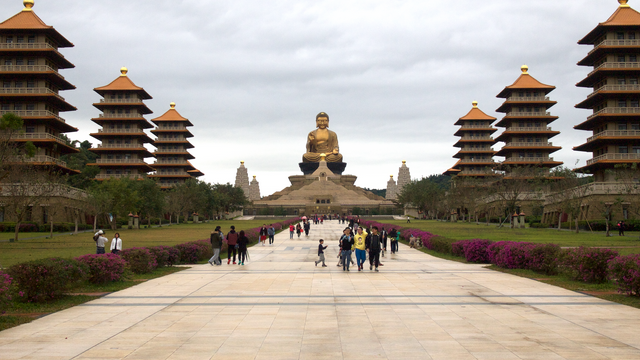
- Fo Guang Shan Buddha Museum and Memorial Building, No. 1, Tongling Rd, Dashu, Kaohsiung 840 (there are several shuttle buses from Zuoying, Dashu and the Main Station (bus 8010) in Kaohsiung – see monastery website, +886 7 6563033. One of Taiwan's largest Buddhist monasteries – Chan (Zen) tradition. While amount of impressive monasteries in Taiwan is rare, this place is the one must see destination, even if you are not into Buddhism. The monastery area is the manifestation of a new and modern Buddhism interpretation (Fo Guang Shan), founded in 1967. Like the Bahá'í Gardens in Haifa (Israel), this place is free and offers complementary tours. Do not miss out on this picturesque and unique monastery. Arrive early (09:00) and get some unspoilt pictures. Also try [mailto:fgsbmc-intl@ecp.fgs.org.tw this email address].
Fo Guang Shan Buddha Museum and Memorial Building, No. 1, Tongling Rd, Dashu, Kaohsiung 840 (there are several shuttle buses from Zuoying, Dashu and the Main Station (bus 8010) in Kaohsiung – see monastery website, +886 7 6563033. One of Taiwan's largest Buddhist monasteries – Chan (Zen) tradition. While amount of impressive monasteries in Taiwan is rare, this place is the one must see destination, even if you are not into Buddhism. The monastery area is the manifestation of a new and modern Buddhism interpretation (Fo Guang Shan), founded in 1967. Like the [[Haifa#See|Bahá'í Gardens in Haifa (Israel)]], this place is free and offers complementary tours. Do not miss out on this picturesque and unique monastery. Arrive early (09:00) and get some unspoilt pictures. Also try [mailto:fgsbmc-intl@ecp.fgs.org.tw this email address].
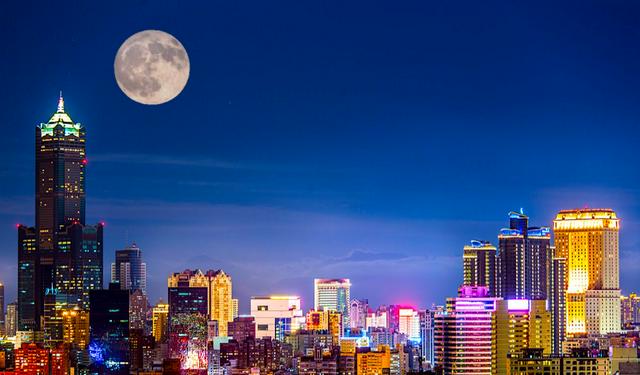
- Pier 2 Art Center, Between Sihzihwan Metro Station and Yanchengpu Metro Station. This former warehouse district has been converted into a series of contemporary art galleries. As these are commercial galleries and not museums, admission tends to be free. Between the warehouses there are numerous outdoor sculptures. The district is near Fishermen's Wharf, which can serve as a great place to grab a meal after a day looking at art.
- Fishermen's Wharf / Banana Pier, Near Sihzihwan Metro Station. This tourist area features a number of restaurants with live performers and seaside seating. There is also a free exhibit within Banana Pier about Taiwan's banana industry.
Pier 2 Art Center, Between Sihzihwan Metro Station and Yanchengpu Metro Station. This former warehouse district has been converted into a series of contemporary art galleries. As these are commercial galleries and not museums, admission tends to be free. Between the warehouses there are numerous outdoor sculptures. The district is near Fishermen's Wharf, which can serve as a great place to grab a meal after a day looking at art.
Fishermen's Wharf / Banana Pier, Near Sihzihwan Metro Station. This tourist area features a number of restaurants with live performers and seaside seating. There is also a free exhibit within Banana Pier about Taiwan's banana industry.
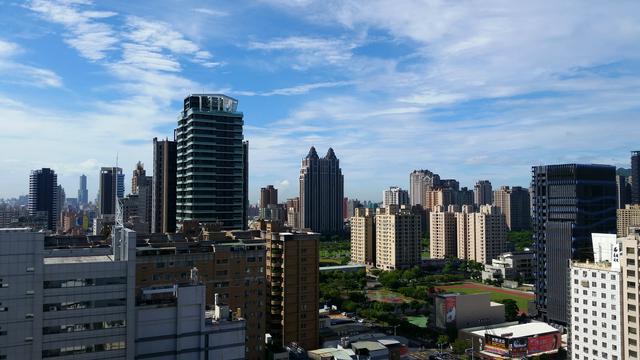
- Lotus Lake, Zuoying District. Take a walk or bike around Lotus Lake. The lake is surrounded by temples, some of which have built out onto the lake. Of note are the Dragon-Tiger Pavilion and Spring Autumn Pavilion, as well as Taiwan's largest Confucius temple. During the day the lake is surrounded with stalls selling food, drinks and trinkets. Across the street from the Dragon-Tiger Pavilion is a Taiwanese puppet shop that's worth checking out. Just south of the lake is one of the restored gates of the Old Wall of Fongshan, built in 1826. A few blocks down on Shengli Road is the North Gate, the best-preserved of the three. On the other side of the gate is a new park and the Military Dependents' Museum, which features many vintage Taiwanese household items.
- Pei Chi Pavilion (北極亭), On Lotus Lake in Zuoying District. Beiji TempleThis large statue of Beiji sits on Lotus Lake. The plank connecting the statue to the shore is lined with a series of beautiful sculptures of animals. The statue itself is hollow and contains a temple within. Although relatively recently constructed, this statue is colorful, colossal, and well worth a visit.
- Spring & Autumn Pavilions (春秋閣), On Lotus Lake in Zuoying District. Dragon and Tiger temple in Lotus LakeThis Taoist temple complex contains a large dragon that you can enter. The inside of the dragon is beautifully painted with murals. Once you are done sightseeing within the dragon, you can exit out its opposite end. The nearby Dragon-Tiger Pavilion is also worth seeing, and features two pagodas you can visit as well.
Lotus Lake, Zuoying District. Take a walk or bike around Lotus Lake. The lake is surrounded by temples, some of which have built out onto the lake. Of note are the Dragon-Tiger Pavilion and Spring Autumn Pavilion, as well as Taiwan's largest Confucius temple. During the day the lake is surrounded with stalls selling food, drinks and trinkets. Across the street from the Dragon-Tiger Pavilion is a Taiwanese puppet shop that's worth checking out. Just south of the lake is one of the restored gates of the Old Wall of Fongshan, built in 1826. A few blocks down on Shengli Road is the North Gate, the best-preserved of the three. On the other side of the gate is a new park and the Military Dependents' Museum, which features many vintage Taiwanese household items.
Pei Chi Pavilion (北極亭), On Lotus Lake in Zuoying District. This large statue of Beiji sits on Lotus Lake. The plank connecting the statue to the shore is lined with a series of beautiful sculptures of animals. The statue itself is hollow and contains a temple within. Although relatively recently constructed, this statue is colorful, colossal, and well worth a visit.
Spring & Autumn Pavilions (春秋閣), On Lotus Lake in Zuoying District. This Taoist temple complex contains a large dragon that you can enter. The inside of the dragon is beautifully painted with murals. Once you are done sightseeing within the dragon, you can exit out its opposite end. The nearby Dragon-Tiger Pavilion is also worth seeing, and features two pagodas you can visit as well.
- Cycle. If you have only a brief period in Kaohsiung, skip Cijin. If you have more than a day, you will find the island to be a pleasant and relaxing place to take a break. Most of the major sites can be seen within two hours. Locals take a ferry to the island, and as a result the ferry is an affordable way to experience a brief boat ride. The elongated island is made for cycling and has a nice cycling track. You can rent a bike either before or after you take the ferry. There is a shop opposite exit 1 of Sizhiwan Station that rents out bikes for NT$59. Average price for bike rental in the area tend to be around NT$100. Once you get off the ferry you can turn right and start biking to the lighthouse and the fort, then continue south along the west coast. Alternatively, you can get off the ferry and continue straight through the market until you hit the beach at the end. From there, you can turn right to the fort and lighthouse or turn left down the bike path along the beach. While visiting, please note that the fort does not have guard rails installed, and may be dangerous for young children to visit, as there are many steep drops.
- Beach.
- Rising Victory Bicycles, * 84 Miao-chien Road, Cijin District, Kaohsiung City., +886 7-571-4513. 09:00-21:00. Make your way to the end of the market from the ferry and, once past the seafood restaurants, you will see the beach. It is public access, but you will need NT$15 for the ferry ride first. There are nice facilities at the beach.
- The Chijin Kiln Studio, * 25 Hai-an Road, Cijin District, Kaohsiung City., +886 7-5721678. Tu-F 12:00-21:00, Sa-Su 11:00-21:00.
Cycle. If you have only a brief period in Kaohsiung, skip Cijin. If you have more than a day, you will find the island to be a pleasant and relaxing place to take a break. Most of the major sites can be seen within two hours. Locals take a ferry to the island, and as a result the ferry is an affordable way to experience a brief boat ride. The elongated island is made for cycling and has a nice cycling track. You can rent a bike either before or after you take the ferry. There is a shop opposite exit 1 of Sizhiwan Station that rents out bikes for NT$59. Average price for bike rental in the area tend to be around NT$100. Once you get off the ferry you can turn right and start biking to the lighthouse and the fort, then continue south along the west coast. Alternatively, you can get off the ferry and continue straight through the market until you hit the beach at the end. From there, you can turn right to the fort and lighthouse or turn left down the bike path along the beach. While visiting, please note that the fort does not have guard rails installed, and may be dangerous for young children to visit, as there are many steep drops.
Beach.
Rising Victory Bicycles, * 84 Miao-chien Road, Cijin District, Kaohsiung City., +886 7-571-4513. 09:00-21:00. Make your way to the end of the market from the ferry and, once past the seafood restaurants, you will see the beach. It is public access, but you will need NT$15 for the ferry ride first. There are nice facilities at the beach.
The Chijin Kiln Studio, * 25 Hai-an Road, Cijin District, Kaohsiung City., +886 7-5721678. Tu-F 12:00-21:00, Sa-Su 11:00-21:00.
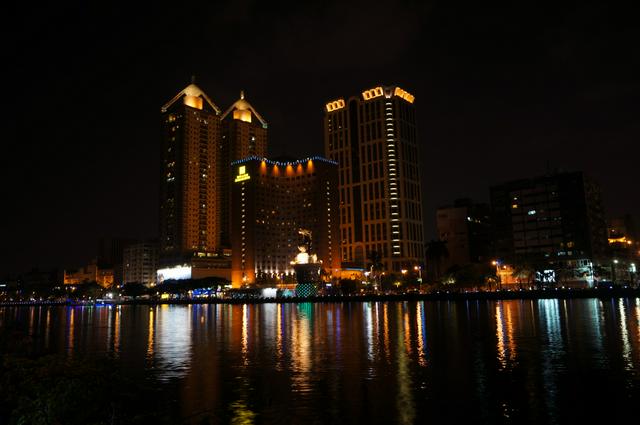
- Kaohsiung Lantern Festival. At the end of Chinese New Year, near the Kaohsiung harbour and along the Love River, the Kaohsiung Lantern Festival is filled with a variety traditional lanterns and more modern light sculptures, nightly fireworks shows, Taiwanese food stands and other art programs and live concerts.
- Urban Spotlight. Located at the corner of Central Park, Urban Spotlight is a cafe with a stage where local live bands perform in the evening. Take a walk around Central Park then stop at the cafe to cool off.
- Night Markets.Food, games, and shopping. Try the Liuho Night Market, which is a tourist market. Ruifeng night market, at the corner of YuCheng and Nanping, heaves with locals. Closed Mondays and Wednesdays.
- Take a nighttime stroll along the promenate of the Love River and enjoy the live musice, a coffee or an ice cream in one of the cafes.
- Go to the top of the 85 Tower, the second tallest building in Taiwan.
- Hike Monkey Mountain (壽山; Shòu shān) and enjoy the view of the city and the ocean. Beware of the namesake monkeys, who have been known to steal hikers' food, drinks, and even cameras.
Kaohsiung Lantern Festival. At the end of Chinese New Year, near the Kaohsiung harbour and along the Love River, the Kaohsiung Lantern Festival is filled with a variety traditional lanterns and more modern light sculptures, nightly fireworks shows, Taiwanese food stands and other art programs and live concerts.
Urban Spotlight. Located at the corner of Central Park, Urban Spotlight is a cafe with a stage where local live bands perform in the evening. Take a walk around Central Park then stop at the cafe to cool off.
Night Markets.Food, games, and shopping. Try the Liuho Night Market, which is a tourist market. Ruifeng night market, at the corner of YuCheng and Nanping, heaves with locals. Closed Mondays and Wednesdays.
There are numerous seafood restaurants dotting the main street in Cijin Island, all offering the same fresh seafood for about NT$100-200 per dish. It is a great idea to go in a small group and order a few dishes to try, probably one more dish than the number of people in your group. In the evening, a night bazaar goes into full swing. There are lots of little eats to eat as per Taiwan's night markets, BBQ squid, mochi to name a few are particularly good.
- Flavor of the Sea Seafood Restaurant, * 75 Miao-chien Road, Cijin District, Kaohsiung City., +886 7-5711861.
- Wen-Chin Seafood Restaurant, * 28 Miao-chien Road, Cijin District, Kaohsiung City., +886 7-5714568. 11:00-22:30.
- Man-San Seafood Retaurant, No.179-11, Jhongjhou 2nd Rd., Cijin District, Kaohsiung City 805, Taiwan (R.O.C.), +886 7-5714191. 11:00-21:00.
- Riverside Sea Food Restaurant, * 68-16, Chong-chou Second Road, Cijin District, Kaohsiung City., +886 7-5713485.
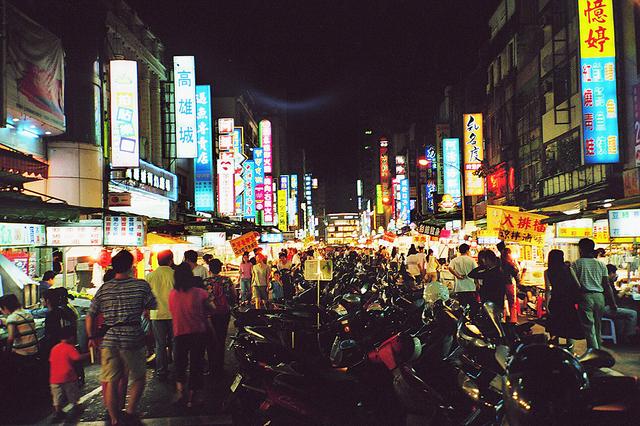
Night markets are a great place to pick up cheap local foods, including stinky tofu, barbecued squid, red bean pancakes and the like.
The Liuhe Night Market (六合夜市) is the most typical tourist night market and offers local dishes such as salty glutinous rice balls (鹹湯圓) stuffed with pork, oyster omelette (蚵仔煎) and tofu pudding (豆花). This market is very popular with Mainland Chinese tourist groups, open pretty much every day after 17:00/18:00 and convienently located at MRT Formosa Boulevard.
A more local, food-oriented night market is Rueifong Night Market (瑞豐夜市), straight outside exit 1 of MRT Kaohsiung Arena. It is open Tue, Thu, Fri, Sat, Sun, but if you are afraid of crowds you should avoid the weekends. A similar night market is 青年夜市 near MRT Da-Dong.
Lunchboxes are common throughout the city, and a choose-your-order buffet take-out are typically NT$50-100. The food is typically fried, with a mix of vegetables and meats.
The ubiquitous 7-Eleven stores have tea eggs, hot dogs, packaged beverages and junk food. Lunchbox style microwavables are also available, including dumplings, spaghetti and curry rice.
- Smokey Joes offers Tex-Mex, including fajitas, tortillas and other Western staples at affordable prices (NT$170 and up). The menu is in English and the staff usually understands some English as well. They offer a 'VIP' card for people who spend over NT$1,000 on 20 separate meals which gives the holder at 10% discount at any store operated by Amy (the owner of Smokey Joes). This includes Mama Mia's, an Italian restaurant located downtown.
- The Pantheon serves traditional Greek and Mediterranean food at good prices. They are known for their Gyro lunch (around NT$200), qne hey also offer a 20% discount on takeout.
- Cosplay Cafe, +886 7 235-0128. daily noon-21:30. Offers a cosplay themed restaurant. 161, ChangMing St, SanMin District. English language review
- Bull Fighter Restaurant, 79, Wu Fu 3rd Road, Cianjin District (downtown near Love River, +886 7 241-5530. It mainly serves steaks and grilled seafoods and is suitable for most Western visitors at fair costs (NT$400-500 each, free salad bar included). Or, you can choose pastas (only NT$200, salad bar included).
- Escape 41 a little bit hard to get to without your own transportation (if you are sporty, a bicycle will do, but don't be afraid of uphill-riding, cab might drop you off there as well) though you'll be rewarded. Its located directly on the coastline behind Zhongshan University, far off the cities hustle and bustle. Great at sunsets, big terrace; western food, not cheap but ok. 41-2, CaiShan, Gushan District(07) 525-0058.
- Michino Diner, serving popular breakfast and brunch. You can choose between burgers, sandwiches, salads, omelettes and real American breakfast and brunch at NT$150-300. Tel:(07) 216-2290 Address: #79 Datong 1st Rd (高雄巿新興區大同一路79號) Hours: Tu-Su 10:00-22:00
- Sushi Express. Sushi train with good variety including healthy vegetarian options. NT$30 per plate.
Smokey Joes offers Tex-Mex, including fajitas, tortillas and other Western staples at affordable prices (NT$170 and up). The menu is in English and the staff usually understands some English as well. They offer a 'VIP' card for people who spend over NT$1,000 on 20 separate meals which gives the holder at 10% discount at any store operated by Amy (the owner of Smokey Joes). This includes Mama Mia's, an Italian restaurant located downtown.
The Pantheon serves traditional Greek and Mediterranean food at good prices. They are known for their Gyro lunch (around NT$200), qne hey also offer a 20% discount on takeout.
Cosplay Cafe, +886 7 235-0128. daily noon-21:30. Offers a cosplay themed restaurant. 161, ChangMing St, SanMin District. English language review
Bull Fighter Restaurant, 79, Wu Fu 3rd Road, Cianjin District (downtown near Love River, +886 7 241-5530. It mainly serves steaks and grilled seafoods and is suitable for most Western visitors at fair costs (NT$400-500 each, free salad bar included). Or, you can choose pastas (only NT$200, salad bar included).
Escape 41 a little bit hard to get to without your own transportation (if you are sporty, a bicycle will do, but don't be afraid of uphill-riding, cab might drop you off there as well) though you'll be rewarded. Its located directly on the coastline behind Zhongshan University, far off the cities hustle and bustle. Great at sunsets, big terrace; western food, not cheap but ok. 41-2, CaiShan, Gushan District(07) 525-0058.
Michino Diner, serving popular breakfast and brunch. You can choose between burgers, sandwiches, salads, omelettes and real American breakfast and brunch at NT$150-300. Tel:(07) 216-2290 Address: #79 Datong 1st Rd (高雄巿新興區大同一路79號) Hours: Tu-Su 10:00-22:00
Sushi Express. Sushi train with good variety including healthy vegetarian options. NT$30 per plate.
- The Spice Shop, 508 Mingcheng 2nd Road, +886 7 558-5709. An Indian restaurant serving a-la-carte style meals, with each dish ranging from NT$120-270.
There is also a Ruth's Chris, an Outback and several steak houses in town.
The Spice Shop, 508 Mingcheng 2nd Road, +886 7 558-5709. An Indian restaurant serving a-la-carte style meals, with each dish ranging from NT$120-270.
Flavor of the Sea Seafood Restaurant, * 75 Miao-chien Road, Cijin District, Kaohsiung City., +886 7-5711861.
Wen-Chin Seafood Restaurant, * 28 Miao-chien Road, Cijin District, Kaohsiung City., +886 7-5714568. 11:00-22:30.
Man-San Seafood Retaurant, No.179-11, Jhongjhou 2nd Rd., Cijin District, Kaohsiung City 805, Taiwan (R.O.C.), +886 7-5714191. 11:00-21:00.
Riverside Sea Food Restaurant, * 68-16, Chong-chou Second Road, Cijin District, Kaohsiung City., +886 7-5713485.
Two local beer companies, Tsingtao and Taiwan Beer, are ubiquitous throughout the island and can be purchased by visitors cheaply with little hassle about age restrictions. Most major soft drinks are available, and tea stands on almost every corner offer concoctions of fruit, yogurt, green tea, the Taiwanese specialty "bubble tea," and a variety of other flavors.
While tap water is most certainly not potable, good reverse osmosis filtration will remove bacteria and heavy metals, and is considered safe for consumption. Water dispensers, which resemble gas stations, are present throughout the city. However, they, along with many of the bottled water brands, are suspect. Both have been found, in the past, to simply bottle or distribute tap water. To avoid ingesting non-potable water, only purchase bottles that are sealed with an expiration date clearly printed on the bottle. Often, it is easier to simply purchase green tea at a stand or a convenience store, or a soft drink. Restaurant water is safe, with the exception of some lunchbox eateries and stands on the street.
- 2 Coins Bar, 350 Fujian St (½ block from the Lees Hotel at Wu-Fu 1st Road and Fujian. 2 Coins Bar is a small bar down the street from the Lees Hotel. The bar owner is quite nice, but doesn't speak English. Good music and decent prices are standard for this relaxing bar.
- Green Creek Cafe, * 2, Hai-an Rd., Cijin District, Kaohsiung City., +886 7-5720157. 07:00-23:00.
- La Mambo Cafe & Dine, 2F., #10, Hai-an Road, Cijin District, Kaohsiung City, +886 7-5721998. 11:00-23:00.
- Lamp, 3F, 42 Zihciang 3rd Rd (MRT Sanduo Shopping District Station Exit 1, across from the 2 legged skyscraper. Tu-Su 22:00-04:00.
- Brickyard, 507 Jhongshan Rd (MRT 2 blocks south of Central Park Station. Club nights W, F, Sa. Door charge on F and Sa: men NT$300, women NT$150.
Lamp, 3F, 42 Zihciang 3rd Rd (MRT Sanduo Shopping District Station Exit 1, across from the 2 legged skyscraper. Tu-Su 22:00-04:00.
Brickyard, 507 Jhongshan Rd (MRT 2 blocks south of Central Park Station. Club nights W, F, Sa. Door charge on F and Sa: men NT$300, women NT$150.
- Siang Shia Zou, B1, 323 Xintian Rd (behind Hanshin Department Store. 18:00-02:00.
- Roof Island, 51 Liwen Road, Zouying Dist (MRT station Kaoshiung Areana. 18:30-03:00.
Siang Shia Zou, B1, 323 Xintian Rd (behind Hanshin Department Store. 18:00-02:00.
Roof Island, 51 Liwen Road, Zouying Dist (MRT station Kaoshiung Areana. 18:30-03:00.
2 Coins Bar, 350 Fujian St (½ block from the Lees Hotel at Wu-Fu 1st Road and Fujian. 2 Coins Bar is a small bar down the street from the Lees Hotel. The bar owner is quite nice, but doesn't speak English. Good music and decent prices are standard for this relaxing bar.
Green Creek Cafe, * 2, Hai-an Rd., Cijin District, Kaohsiung City., +886 7-5720157. 07:00-23:00.
La Mambo Cafe & Dine, 2F., #10, Hai-an Road, Cijin District, Kaohsiung City, +886 7-5721998. 11:00-23:00.
Kaohsiung's crime rate is much lower than probably any city of comparable size in the West, so tourists need not be too worried. Theft tends to be the most common form of criminal activity encountered by foreigners, and expensive bikes and scooters are frequent targets.
As a major seaport, organized crime has also become an increasing problem in the city, and a fair number of businesses are nothing more than a front for local gangs. That said, the gangs do not resort to random violence or theft.
In general, Kaohsiung offers a very safe environment as long as you mind your own business and don't get involved with local rivalries. Violent crime is very rare, and visitors should not encounter any problems - though, like any major city, it is always wise to err on the side of caution.
Also please remember: tap water is not potable.
- Tainan is to the north. It can easily be accessed by train or car. There is a regular train service from Kaohsiung Central Train Station. The journey takes around 30 minutes, which makes Tainan an attractive day-trip or even half-day destination.
- Pingtung County is to the south. All the way to its southern end is Kenting.
- Taitung County is to the east. However, the Southern Cross-Island Highway ( Provincial Highway Number 20) has been closed mid-way since 2009 due to the Typhoon Morakot, so you have to take a very long detour via the South-Link Highway ( Provincial Highway Number 9) if going by road.
- Penghu – An outlying island archipelago, with a saturated turquoise sea around and coral sand, so pack beach wear.
